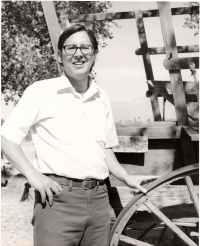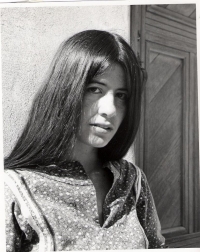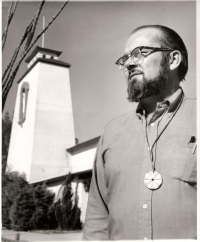Story from CODA (POETS' & WRITERS) about Clark's photos of poets in FACE OF POETRY
Headline: Arizona Photographer Reads Before She Shoots
LaVerne Harrell Clark, whose photos of poets are featured in this issue of Coda, is primarily a folklorist and fiction writer. Her collection of Navajo and Apache folklore, They Sang for Horses (University of Arizona Press, 1966) won the Folklore Prize from the University of Chicago. Her short stories have been published in Daedalian, Pawn Review, and other literary magazines. She has done folklore field work in Spain, Mexico, and the Southwestern U.S.A. and researched the travels of D.H. Lawrence in Mexico and Europe. Both she and her husband, L.D. Clark, are listed in A Directory of American Fiction Writers.
LaVerne shoots poets with a folklorist's conscience, never forgetting the background. Behind Richard Shelton are the Tucson Mountains he writes about. Peter Wild appears with his backpack before the Catalina Mountains, where he hikes almost weekly. Joy Harjo is shown against a door like those of the pueblos, recalling her poem, "Isleta Woman Singing." Keith Wilson poses near a Spanish-style church with an Ocotillo branch, evoking the New Mexican mission villages he writes about.
LaVerne published her first portrait of a poet, Robert P.T. Coffin, in American Scandinavian Review [magazine] while she was taking creative writing courses at Columbia University in New York.
Her contact with poets increased when she moved to Tucson and was afterwards chosen to be the University of Arizona Poetry Center's first director, serving in the post from 1962 to 1966, and after leaving the position, has continued to do photography for the Center as time allowed. She left her post after the publication of her first book in order to devote full time to her own writing career.
Today a large number of her portraits hang in the Center's halls and gallery. Publications featuring her work include Poetry Now, Great Lakes Review, New York Quarterly, and several anthologies and small press publications.
In bringing out the book, Gallimaufry Press (Arlington, VA) has published a different kind of poetry anthology, a collection conceived by LaVerne and Gallimaufry's editor, Mary MacArthur. Titled, THE FACE OF POETRY, the book centers on the photos, with the poets adding written "self-portraits" in prose or verse as commentary. The forward is by Richard Eberhardt.
LaVerne's list of poets grows by two or three faces a month. "I've never done as many novelists," she says, "and this is strange; for fiction is my first love, and neither my husband nor I write poetry." LaVerne feels strongly that before making her photographs, she must know the face and hear the poet read first. "I never shoot anyone whose work I haven't read."
Her address, for poets or publishers who need portraits, is supplied in the address box.

Though he is not mentioned in the text, this portrait of the late Blackfoot poet-novelist, James Welch, also appeared with the article. Since Clark photographed him in Tucson rather than in Missoula, she took him to a wagon of bygone days to evoke a Montana scene from his book, RIDING THE EARTHBOY 40. He had read from it for his program, on this, his first ( Nov. 1971), reading for the series of the U. of Arizona Poetry Center.

Though the name of the Creek poet, Joy Harjo, is well-known today, when this portrait of her was made at the Isleta Pueblo outside Albuquerque in 1975, she had just published her first book, THE LAST SONG. The photo session also marked the first of a number of other such occasions which she and Clark have since enjoyed in various places during a friendship that has continued through the years.

While Clark's long friendship with poet Keith Wilson,who is shown before a church near the Tucson Poetry Center, which he then served as a Board member, dates back to his teaching years at the U. of AZ, she chose a background for him,which reminded her of his native N.M. It suggests the kind of Las Cruces desert in which he again lives today and which he continues making use of in his poetry.
